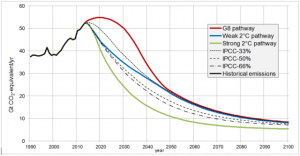David Victor and Charles Kennel write in a recent commentary published by Nature “Politically and scientifically, the 2 °C goal is wrong-headed.” Their commentary has prompted a number of responses – see article in The Guardian by Adam Vaughan and rebuttals by Gavin Schmidt, Bill Hare and others, and Joe Romm.
Victor and Kennel argue that the 2 °C limit suffers from two political problems. First, they assert, keeping below 2 °C is unachievable without “heroic assumptions” about immediate global cooperation and widespread availability of technologies that have not been demonstrated at scale. Second, the 2 °C threshold does not translate into a specific and certain quantity of emissions, and therefore “does not tell particular governments and people what to do.”
Scientifically, the basis for the 2 °C limit, according to Victor and Kennel, is tenuous, in part because changes in average global surface temperature does not track in lock step with climate forcing and climate risks on short time scales. They take the position that a single index of climate change risk is not possible given the complexities of how changes in carbon dioxide concentrations alter climate and other earth systems, and the consequent risks to ecological systems and humans. They advocate for development of a set of indicators, or “planetary vital signs,” to be used by policy makers and the UNFCCC to gauge climate stresses and possible impacts that are “better rooted in the scientific understanding of climate drivers and risks.”
Gavin Schmidt, director of NASA’s Goddard Institute for Space Studies, wrote an excellent rejoinder in Realclimate. He also posted a comment to an article in The Guardian about the Victor-Kennel commentary that nicely matches my take: “If you are driving in completely the wrong direction, arguing about where you’ll park if you arrive isn’t your highest priority.” I have significant doubts about the viability of reaching a comprehensive, top-down, legally binding agreement at COP21 in Paris. But urging parties to the UNFCCC to revisit the hard-won agreement to try to limit warming to < 2 °C, and consider replacing it with targets for an array of planetary vital signs, is an invitation to inaction that would have dangerous repercussions.
Do read Gavin Schmidt’s more detailed assessment of why the 2 °C limit should not be ditched. He makes a good case for the scientific validity for using average global temperature as a reasonable indicator of climate risk, and counters the assertion that the 2 °C limit is technically or economically unachievable.


Andrew Revkin has written about Victor and Kennel’s call to “ditch” the 2 degree limit in his Dot Earth blog, and includes a response from Victor to criticisms by Schmidt and others (see http://dotearth.blogs.nytimes.com/2014/10/03/getting-over-the-2-degree-limit-on-global-warming/?_php=true&_type=blogs&module=BlogPost-Title&version=Blog%20Main&contentCollection=Climate%20Change&action=Click&pgtype=Blogs®ion=Body&_r=0) .
Very long, but worth reading. Victor is a very knowledgeable scholar in the field of climate change governance, and is well versed in the science as well. Having been involved in the development of the IPCC’s ‘burning embers’ figure, I agree that there is considerable fuzziness in associating impacts and risks with specific magnitudes of global mean temperature change. So I’m sympathetic to the view that multiple metrics are needed for monitoring changing pressures from adding GHGs to the atmosphere, and I don’t think Victor and Kennel’s analysis should be dismissed lightly. But on balance, I’m still inclined to the view that the 2 degree limit should not be ditched. It provides a tangible, actionable metric for the climate negotiations that demarcates territory into which we should fear to tread.
I was privileged enough to march in Lima for Climate Change at the COP 20 .While in Lima as a tourist and concerned citizen of the planet I could not help but notice the air quality. I know with Climate Change there are so many issues and layers to be resolved that one wonders where to start.. Personally it is with oneself and the willingness to make personal daily changes. However, on a bigger scale that relates to air quality,planetary temperature and CO 2 emissions I could not help but notice all the cars and how dirty they are. One of my friends a local Peruvian who used to live in America said that when he brought his car from America to Peru that the local car dealership wanted to take out his cadalitic converter . That there is a belief system there of the noisy and dirtier the car the better or more macho.
I suspect this pattern is in many 3rd world countries. It would be very easy to start some basic advertising or education campaign on changing this. With pictures of smug filled cities vs clean, healthy children vs sickly with asthma and cars that run well and get good gas mileage. Also,that it is “COOL” to help the planet. I am hoping someone who reads this will take this idea and run with it. This of course does not magically change all the cars to those that don’t pollute but it would be a FIRST STEP in changing peoples thinking/choices Lima is ripe for this because of the momentum of the COP 20